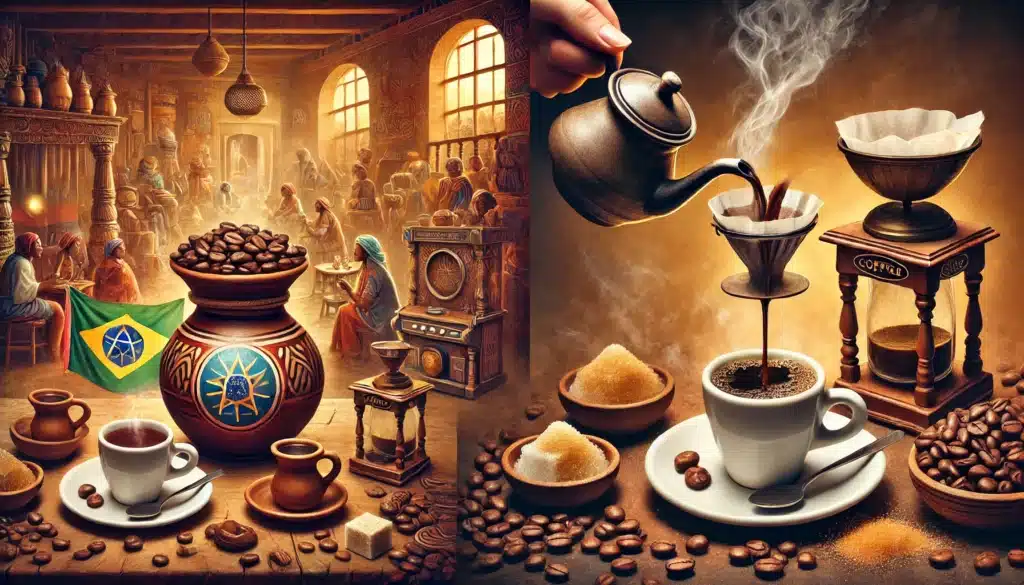Ethiopia is the birthplace of coffee, where coffee is deeply tied to history and tradition. Brazil, on the other hand, is the largest coffee producer in the world, known for its vast coffee farms and smooth, chocolatey beans.
Both countries love coffee, but their flavors, growing methods, and cultural traditions are completely unique.
In this guide, we’ll compare:
✅ The history and coffee traditions of Ethiopia and Brazil
✅ How their coffee is grown, processed, and brewed
✅ The key differences in taste and style
✅ How to brew Ethiopian and Brazilian coffee at home
Let’s explore these two coffee giants! 🇪🇹🇧🇷☕
A Brief History of Ethiopian and Brazilian Coffee
🇪🇹 Ethiopia: The Birthplace of Coffee
Coffee was discovered in the 9th century, according to the legend of Kaldi and his dancing goats.
Ethiopia still has thousands of wild coffee varieties growing naturally.
Coffee is central to Ethiopian social life, with the traditional coffee ceremony being a key cultural practice.
💡 Fun Fact: Ethiopia is the only country in Africa that consumes more coffee than it exports.
🇧🇷 Brazil: The World’s Coffee Powerhouse
Coffee arrived in Brazil in 1727, smuggled from French Guiana.
By the 19th century, Brazil became the world’s largest coffee producer—a title it still holds today.
Brazil’s massive coffee farms produce 40% of the world’s coffee supply.
💡 Fun Fact: The famous coffee break (cafezinho) is a Brazilian tradition—you’re offered coffee everywhere you go!
How Coffee is Grown: Ethiopia vs. Brazil
| Feature | Ethiopia 🇪🇹 | Brazil 🇧🇷 |
|---|---|---|
| Coffee Type | Almost 100% Arabica | Mostly Arabica & some Robusta |
| Farms | Small, family-owned farms | Large commercial plantations |
| Altitude | 1,500-2,200m (high altitude) | 800-1,200m (lower altitude) |
| Processing | Washed (wet) & Natural (dry) | Mostly Natural (dry) |
| Flavors | Bright acidity, floral, fruity | Smooth, chocolatey, nutty |
💡 Ethiopian coffee is grown at higher altitudes, which gives it a more complex, fruity taste.
How Coffee is Processed: Ethiopia vs. Brazil
🇪🇹 Ethiopian Coffee Processing
- Washed (Wet) Process: Produces clean, floral, and bright flavors (common in Yirgacheffe and Sidamo).
- Natural (Dry) Process: Produces wild, fruity, and wine-like flavors (common in Harrar and Guji).
💡 Ethiopia is famous for its complex, fruity coffees—great for pour-over and black coffee lovers.
🇧🇷 Brazilian Coffee Processing
- Natural (Dry) Process: Produces sweet, smooth, and chocolatey flavors.
- Pulped Natural Process: A mix between wet and dry, giving a balanced, nutty, and creamy body.
💡 Brazilian coffee is smooth, making it great for espresso, lattes, and cafézinho!
Ethiopian vs. Brazilian Coffee Flavor Profiles
| Feature | Ethiopian Coffee 🇪🇹 | Brazilian Coffee 🇧🇷 |
|---|---|---|
| Acidity | High (bright, citrusy) | Low (smooth, mild) |
| Body | Light to medium | Medium to full |
| Sweetness | Fruity, floral | Chocolatey, nutty |
| Best For | Pour-over, black coffee | Espresso, cafézinho, milk-based drinks |
💡 Love bright, tea-like coffee? Try Ethiopian beans. Prefer smooth, creamy coffee? Go for Brazilian!
How Coffee is Brewed: Ethiopia vs. Brazil
🇪🇹 Traditional Ethiopian Coffee Ceremony
Coffee is roasted, ground, and brewed fresh in a clay pot called a jebena.
Served strong and black, often with salt or butter instead of sugar.
Three rounds of coffee are served: Abol (first), Tona (second), and Baraka (third).
💡 Ethiopian coffee ceremonies are a sign of hospitality and take up to two hours!
🇧🇷 Cafézinho: The Brazilian Coffee Ritual
A small, strong, sweet coffee brewed in a cloth filter (coador) or espresso machine.
Served throughout the day—at home, at work, and in cafés.
Always pre-sweetened unless requested “sem açúcar” (without sugar).
💡 Cafézinho is about quick energy and social connection—always shared!
How to Brew Ethiopian and Brazilian Coffee at Home
☕ Ethiopian Pour-Over Coffee (V60 or Chemex)
✔ Beans: Ethiopian Yirgacheffe or Sidamo
✔ Grind: Medium-fine
✔ Water: 200ml at 195-205°F (90-96°C)
✔ Brew Time: 3-4 minutes
Steps:
1️⃣ Bloom coffee with 30ml water (30 seconds).
2️⃣ Slowly pour remaining water in circular motions.
3️⃣ Let it drip and enjoy the bright, floral flavors!
💡 Best for: Coffee lovers who enjoy black coffee with complex, fruity notes.
☕ Brazilian Cafézinho (Sweet, Strong Coffee)
✔ Beans: Brazilian Santos or Cerrado
✔ Grind: Fine (like espresso)
✔ Water: 100ml boiling water
✔ Sugar: 1-2 teaspoons
Steps:
1️⃣ Heat sugar and water together.
2️⃣ Add coffee grounds and stir.
3️⃣ Strain through a cloth filter (coador) or metal strainer.
4️⃣ Serve in a small cup—sweet and strong!
💡 Best for: Those who love rich, smooth, slightly sweet coffee.
Final Thoughts: Which Coffee Should You Try?
✔ Love floral, fruity, complex coffee? Try Ethiopian beans.
✔ Prefer smooth, nutty, chocolatey coffee? Go for Brazilian beans.
✔ Enjoy slow, mindful coffee experiences? Ethiopian coffee ceremonies are for you.
✔ Want quick, strong, and sweet coffee? Cafézinho is your go-to.
Both Ethiopia and Brazil are coffee legends, offering completely different but equally amazing coffee experiences.
So, which one do you prefer—Ethiopia’s bright and floral coffee, or Brazil’s smooth and chocolatey brews? 🇪🇹☕🇧🇷







